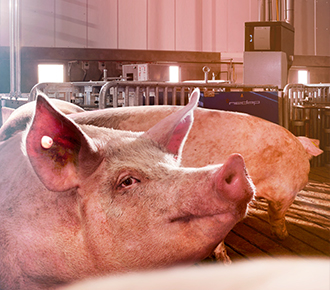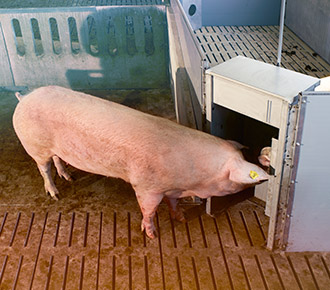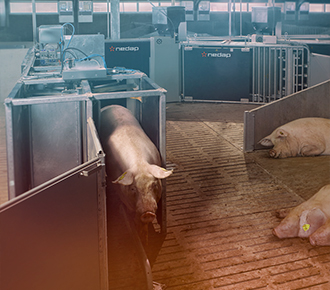"Now we know exactly how much each sow is eating.”
Who?
Dave Denys
Owner
Where?
Parkhill, Ontario
About the farm
- 250-sow farrow to finish
- Remodeled 15-year-old barn
Nedap solutions
Results
Remodel transforms barn
More productive sows with less feed
Dave Denys cut his sow feed use by 20% and is seeing improved sow performance after he remodeled his sow barn with Nedap Livestock Management.
In just four days, Denys transformed his individual-stall gestation barn, originally built in 2002, into one large group pen with Nedap Electronic Sow Feeding. Denys also has Automated Heat Detection and Automatic Sow Separation on the 250-sow farrow-to-finish operation near Parkhill, Ontario, he runs with his father and brother-in-law.
Since the remodel, Denys has seen a marked improvement in sow body condition and performance. He’s also spending less money on feed and enjoying a much calmer environment.
“Remodeling our barn was an easy and inexpensive route to take,” says Denys. “It was an easy choice to go with Nedap. They’ve been around for a long time – they’re not a fly-by-night company and have an excellent support team.”
Problem-free start-up
To free up space for construction, Denys moved some sows into an old gestation barn and shipped market hogs light for a short time. He tore out stalls and did minor concrete work in half of the barn while sows remained in stalls in the other half. Then he moved his sows to the renovated side and pulled the rest of the stalls. Once the work was complete, he repopulated the barn with his herd.
“There were no start-up problems, nothing,” Denys says. “Everything worked really great.”
The Nedap team, working with local dealer Caris Welding, helped Denys design his new pen with resting areas over the solid walkways of the original flooring.
Sows are in better condition
Saving 20 percent on feed
Denys knew he was using too much feed in his old stalled system, but he was surprised to find out how much. He is feeding about 20% less feed than before the remodel.
“With Nedap Electronic Sow Feeding, sows can’t access extra feed out of drops like they do in stalls,” says Denys. “I don’t have to worry about aggressive sows stealing feed from other sows, and I know exactly how much feed each animal is eating.”
Precise feeding with Nedap Electronic Sow Feeding has improved his herd’s sow body condition, which is leading to more weaned pigs entering the nursery.
“We are on track to wean 28 pigs per sow per year because the sows are in better condition. That’s two more pigs per sow per year than before,” says Denys. “An overweight sow usually bears fewer live pigs and doesn’t milk as well. We don’t have that problem anymore. We know what each sow is eating.”

Forward-exit design
Positive change in sow behavior
Not only are his gestating sows in better condition, but Denys also loves the change in his herd’s behavior since installing Nedap Electronic Sow Feeding.
“My pigs aren’t aggressively fighting. They mingle calmly with each other,” says Denys. “There is no fighting around the feeder entrance, either.”
Denys attributes the calm atmosphere to Nedap Electronic Sow Feeding’s forward-exit only design, which prevents fed sows from interacting with unfed sows waiting to eat. A wall along the middle of the pen further prevents immediate contact between fed and unfed sows.
“When a sow leaves the feed unit, she has to walk down the full length of the barn and back again. Most of the time on her walk back, she decides to lay down and sleep,” says Denys. “With other styles of feeding systems, sows want to get back into the feeder, which creates aggression and puts more wear and tear on equipment.”
Easy-to-use system saves time
In addition to the quiet atmosphere the Nedap system creates on his farm, Denys appreciates how it saves him time.
“Our sow barn needs less maintenance now because we aren’t spending time fixing loose stalls,” says Denys. “We also save time by not having to find sows to move them to farrow. Nedap Automated Sow Separation finds them and sorts them out for us. We also save time because our sows are easier to handle than when we had them in stalls.”
The system also eliminates potential production loss by helping Denys identify changes in sow behavior that could indicate something is wrong.
“When the system alerts us that a sow isn’t eating, we go into the pen to see what’s wrong. If the sow has a sore foot or another type of problem, we pull her out,” says Denys. “In individual gestation stalls, you don’t have that level of observation. You don’t know if a sow isn’t eating or how much of her feed the sow next to her ate. Now we know exactly how much each sow is eating.”
Solutions designed with the sow in mind
Are you thinking about remodeling your barn? How would saving 20% on feed change your operation?
Search results for: ''
There are no results matching your criteria. Please try again with different criteria.


